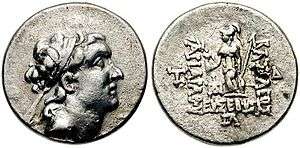Ariarathes IV of Cappadocia
Ariarathes IV, surnamed Eusebes, "the Pious", (Ancient Greek: Ἀριαράθης Εὐσεϐής, Ariaráthēs Eusebḗs), was the king of Cappadocia in 220–163 BC.

Early life
Ariarathes IV was the son of the king of Cappadocia Ariarathes III and his Greek Macedonian wife Stratonice.[1] He was a child at his accession, and reigned for about 57 years.[2] He married his cousin Antiochis, the daughter of Antiochus III the Great, king of Syria, and Laodice III, and, in consequence of this alliance, assisted Antiochus in his war against the Romans. After the defeat of Antiochus by the Romans in 190 BC, Ariarathes sued for peace in 188, which he obtained on favourable terms, as his daughter, Stratonice, was about that time betrothed to Eumenes II, king of Pergamum, whom she later married, and became an ally of the Romans. In 183–179 , he assisted Eumenes in his war against Pharnaces, king of Pontus. Polybius mentions that a Roman embassy was sent to Ariarathes after the death of the Seleucid Antiochus IV Epiphanes, who died 164.
Antiochis, the wife of Ariarathes, is said to have at first borne him no children, and accordingly substituted two surrogates, who were called Ariarathes and Orophernes. Subsequently, however, it was said that she actually bore her husband two daughters and a son, who was named Mithridates, and afterwards became Ariarathes V, and then she informed Ariarathes of the deceit she had practiced upon him. The two surrogates were in consequence sent away from Cappadocia, one to Rome, the other to Ionia.[3]
Notes
- Boyce, Mary; Grenet, Frantz (1991). A History of Zoroastrianism: Zoroastrianism Under Macedonian and Roman Rule. BRILL. pp. 267–8. ISBN 9004092714.
His son Ariarathes IV (220-c.162), thus half-Macedonian by blood, set the title “king” on his coins, and attached to his name the cognomen Philopator. He also introduced the device of Athena holding Nike, which became the standard reverse type of the Ariarathid coinage. […] His son Ariarathes V (c.162-130), with the cognomen Eusebes, was an ardent philhellene, and no longer wears the tiara on any of his coins. In his youth he studied in Athens, where he became friends with the future Attalus III, the last king of Pergamum. He in his turn married a Seleucid princess, his cousin Nysa, daughter of Antiochus III; and he refounded Mazaka and Tyana as Greek poleis…
- Diodorus Siculus, Bibliotheca, xxxi. 3; Justin, xxix. 1; Polybius, iv. 2
- Livy, xxxvii. 31, xxxviii. 38, 39; Polybius, xxi. 43, 47, xxiv. 8, 9, xxv. 2, xxxi. 13, 14, 17; Appian, "The Syrian Wars", 5, 32, 42; Diodorus, xxxi. 3
References
- Appian, The foreign wars, Horace White (translator), New York, (1899)
- Hazel, John; Who's Who in the Greek World, "Ariarathes IV", (1999)
- Head, Barclay; Historia Numorum, "Cappadocia", (1911)
- Justin; Epitome of Pompeius Trogus, John Selby Watson (translator); London, (1886)
- Livy; Ab urbe condita, Canon Roberts (translator); New York, (1905)
- Polybius; Histories, Evelyn S. Shuckburgh (translator); London - New York, (1889)
- Settipani, Christian Les Ancêtres de Charlemagne (France: Éditions Christian, 1989).
![]()
| Regnal titles | ||
|---|---|---|
| Preceded by Ariarathes III |
King of Cappadocia 220 BC – 163 BC |
Succeeded by Ariarathes V |